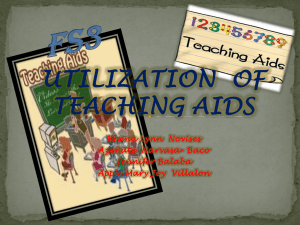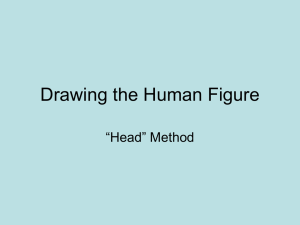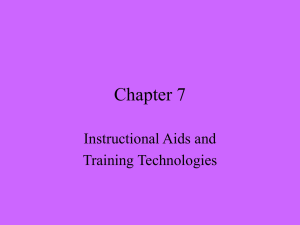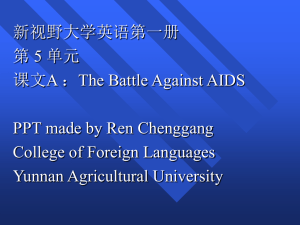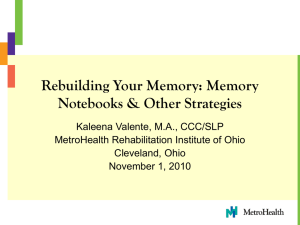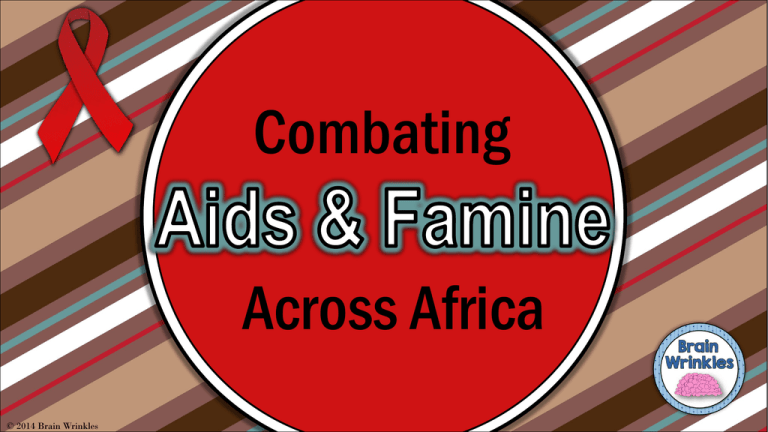
Combating
Across Africa
© 2014 Brain Wrinkles
Standards
SS7CG3 The student will analyze how politics in Africa
impacts standard of living.
b. Describe the impact of government stability on the
distribution of resources to combat AIDS and famine across
across Africa.
© 2014 Brain Wrinkles
Teacher Directions – CLOZE Notes
• The next 2 pages are handouts for the students to use for
note-taking during the presentation. (You might want to
print front-to-back so that it’s only 1 page.)
• Check the answers as a class after the presentation.
© 2014 Brain Wrinkles
AIDS
• Acquired Immunodeficiency Syndrome (AIDS) is a ________________that is
spread through blood and other bodily fluids.
• It attacks and destroys the _____________________________, leaving the victim
unable to fight off ________________.
AIDS in Africa
• About _________________________ across the continent have AIDS, and 1.5
million have died.
• These deaths have created over __________________________________.
No Cure
• Scientists haven’t been able to find a vaccine or
_______________________________.
• There are drugs that can _____________________ the progress of the disease called
called antiretroviral drugs (AVTs), but they are expensive and many patients can’t
can’t afford them.
Epidemic
• Poor healthcare systems, poverty, and lack of __________________________, as
well as ignorance about the disease and its causes and prevention, contribute to the
the number of AIDS cases.
• The situation has gotten even worse as a result of ________________ and weak
educational and _______________________________.
• The epidemic now places a ________________ on the healthcare systems on
countries that barely have enough resources to
_______________________________.
• Few African countries have the resources to _____________________________.
Government Stability
• AIDS has become an epidemic in Africa because the ________________
_______________________________ by the lack of stability in African
governments.
• A country’s government stability has a ____________________ on the distribution
distribution of resources to combat AIDS.
South Africa
• AIDS took hold in South Africa just as ______________________________ and the
the country’s focus was on ______________________________ during the early
stages of the AIDS epidemic.
Zimbabwe
• Zimbabwe has one of the ______________________________ of HIV/AIDS in the
the world.
• The country also has
__________________________________________________________
______________________________ —which has made the situation worse.
© 2014 Brain Wrinkles
Nigeria
• In the 1990s, Nigeria’s government began to make AIDS a priority and began to
focus on __________________________________________________________ .
• The nation still struggles, but the government is trying to
______________________________ about prevention.
Botswana
• Botswana has maintained a ___________________________________ since the
country gained independence in 1966.
• As a result, Botswana has the ______________________________ treat AIDS
patients.
• Botswana’s government has provided
_____________________________________ for its citizens.
• It was also the first country to offer the necessary drug therapy for
_________________________________________ .
Famine
• Along with AIDS, __________________is one of Africa’s biggest problems.
• Famine occurs when a region does not have ____________________________for
a long period of time.
• People who are starving can die from __________________.
Climate
• Many African countries face __________________ because of climate changes.
• Repeated drought has plagued Africa since the __________________.
• Soil infertility and erosion have decreased the
________________________________________.
Government Stability
• The stability of a country’s government directly impacts the country’s ability to
____________________________to prevent famine.
• Civil wars interrupt daily life for most people, including farmers, which causes
____________________________.
• Some governments have ____________________________instead of
____________________________for their people.
• Other governments have used ____________________________by denying food
shipments to political enemies.
© 2014 Brain Wrinkles
AIDS
• Acquired Immunodeficiency Syndrome (AIDS) is a disease that is spread through
blood and other bodily fluids.
• It attacks and destroys the immune system, leaving the victim unable to fight off
infections.
AIDS in Africa
• About 23 million people across the continent have AIDS, and 1.5 million have died.
died.
• These deaths have created over 11 million orphans.
No Cure
• Scientists haven’t been able to find a vaccine or prevent the HIV infection.
• There are drugs that can slow down the progress of the disease called antiretroviral
antiretroviral drugs (AVTs), but they are expensive and many patients can’t afford
afford them.
Epidemic
• Poor healthcare systems, poverty, and lack of government organization, as well as
ignorance about the disease and its causes and prevention, contribute to the number
number of AIDS cases.
• The situation has gotten even worse as a result of poverty and weak educational
and public health services.
• The epidemic now places a huge burden on the healthcare systems on countries
that barely have enough resources to handle basic care.
• Few African countries have the resources to treat AIDS patients.
Government Stability
• AIDS has become an epidemic in Africa because the spread of the disease was
overshadowed by the lack of stability in African governments.
• A country’s government stability has a huge impact on the distribution of resources
resources to combat AIDS.
South Africa
• AIDS took hold in South Africa just as Apartheid was ending and the country’s
focus was on stabilizing the country during the early stages of the AIDS epidemic.
© 2014 Brain Wrinkles
Nigeria
• In the 1990s, Nigeria’s government began to make AIDS a priority and began to
focus on prevention, treatment and care.
• The nation still struggles, but the government is trying to educate its citizens
about prevention.
Botswana
• Botswana has maintained a stable democratic government since the country
gained independence in 1966.
• As a result, Botswana has the resources to help treat AIDS patients.
• Botswana’s government has provided education and prevention training for its
citizens.
• It was also the first country to offer the necessary drug therapy for free to infected
infected people.
Famine
• Along with AIDS, famine is one of Africa’s biggest problems.
• Famine occurs when a region does not have enough food for a long period of time.
• People who are starving can die from malnutrition.
Climate
• Many African countries face drought because of climate changes.
• Repeated drought has plagued Africa since the 1970s.
• Soil infertility and erosion have decreased the amount of crops grown.
Government Stability
• The stability of a country’s government directly impacts the country’s ability to
provide enough food to prevent famine.
• Civil wars interrupt daily life for most people, including farmers, which causes
food shortages.
• Some governments have built armies instead of investing in food for their people.
• Other governments have used food as a weapon by denying food shipments to
political enemies.
© 2014 Brain Wrinkles
Combating
Across Africa
© 2014 Brain Wrinkles
•
Acquired Immunodeficiency Syndrome (AIDS) is a
disease that is spread through blood and other bodily
fluids.
•
It attacks and destroys the immune system, leaving the
victim unable to fight off infections.
•
Today, 34 million people worldwide are living with
HIV/AIDS, and two-thirds of those people are in subSaharan Africa.
© 2014 Brain Wrinkles
© 2014 Brain Wrinkles
© 2014 Brain Wrinkles
• Sub-Saharan Africa has one of the highest
HIV/AIDS infections in the world.
• About 23 million people across the continent
have AIDS, and 1.5 million have died.
• These deaths have created over 11 million
orphans.
© 2014 Brain Wrinkles
© 2014 Brain Wrinkles
AIDS Orphans,
Swaziland
© 2014 Brain Wrinkles
•
Unfortunately AIDS cannot be cured.
•
Scientists haven’t been able to find a vaccine or prevent
the HIV infection.
•
There are drugs that can slow down the progress of the
disease called antiretroviral drugs (AVTs), but they are
expensive and many patients can’t afford them.
© 2014 Brain Wrinkles
• The first case of an HIV infection was detected in the
continent of Africa and governments were slow to
respond.
•
© 2014 Brain Wrinkles
Poor healthcare systems, poverty, and lack of
government organization, as well as ignorance about
the disease and its causes and prevention, contribute to
the number of AIDS cases.
• The situation has gotten even worse as a result of
poverty and weak educational and public health
services.
•
The epidemic now places a huge burden on the
healthcare systems on countries that barely have
enough resources to handle basic care.
•
Few African countries have the resources to treat AIDS
patients.
© 2014 Brain Wrinkles
• AIDS has become an epidemic in Africa because the
spread of the disease was overshadowed by the lack of
stability in African governments.
• A country’s government stability has a huge impact on
the distribution of resources to combat AIDS.
© 2014 Brain Wrinkles
Sign in Zambia
2005
© 2014 Brain Wrinkles
• In South Africa, it is estimated that 1 in 5 people may
be infected with AIDS, yet few have access to the AVTs.
• AIDS took hold in South Africa just as Apartheid was
ending and the country’s focus was on stabilizing the
country during the early stages of the AIDS epidemic.
© 2014 Brain Wrinkles
© 2014 Brain Wrinkles
South Africa is running out of space in its cemeteries.
2013
© 2014 Brain Wrinkles
• Zimbabwe has one of the highest rates of HIV/AIDS in
the world.
• The country also has government corruption, civil
unrest, and a suspicion of outside help—which has
made the situation worse.
• Zimbabwe also has a very poor economy, meaning that
the expensive AVTs are impossible for most people to
afford.
© 2014 Brain Wrinkles
• Almost 3 million people in Nigeria are currently infected
with AIDS.
• Even though Nigeria has oil, most Nigerians are relatively
poor and cannot afford treatment.
• In the 1990s, Nigeria’s government began to make AIDS
a priority and began to focus on prevention, treatment
and care.
• The nation still struggles, but the government is trying
to educate its citizens about prevention.
© 2014 Brain Wrinkles
•
Botswana has maintained a stable democratic
government since the country gained independence in
1966.
• As a result, Botswana has the resources to help treat
AIDS patients.
• Botswana’s government has provided education and
prevention training for its citizens.
•
© 2014 Brain Wrinkles
It was also the first country to offer the necessary drug
therapy for free to infected people.
AIDS Education
Outreach Event
© 2014 Brain Wrinkles
•
Along with AIDS, famine is one of Africa’s biggest
problems.
•
Famine occurs when a region does not have enough
food for a long period of time.
•
People who are starving can die from malnutrition.
•
Famines are both human-made and natural.
© 2014 Brain Wrinkles
© 2014 Brain Wrinkles
© 2014 Brain Wrinkles
• Many African countries face drought because of
climate changes.
• Repeated drought has plagued Africa since the
1970s.
• Soil infertility and erosion have decreased the
amount of crops grown.
© 2014 Brain Wrinkles
•
The stability of a country’s government directly impacts
the country’s ability to provide enough food to prevent
famine.
•
Civil wars interrupt daily life for most people, including
farmers, which causes food shortages.
•
Some governments have built armies instead of investing
in food for their people.
•
Other governments have used food as a weapon by
denying food shipments to political enemies.
© 2014 Brain Wrinkles
Teacher Info –
Combating AIDS App
•
Print off the Combating AIDS App pages for each student. (There is a brainstorm
sheet and a final copy page.)
•
Students should create a new app that will slow down (or stop) the spread of the
AIDS virus in Africa (Have the students think about what the African
governments can start doing...)
•
On the final copy, they will turn the information from their brainstorm sheet into a
paragraph about the app.
© 2014 Brain Wrinkles
Combating AIDS App
Directions: Imagine that Apple has hired you to create a new application that will slow down (or stop) the spread of the AIDS virus. (Think about what African governments can
do…) Complete the graphic organizer below to help you organize your thoughts before you create your app.
App Title: ___________________________
Describe the AIDS Epidemic:
What does the app do?
How does the app work? How will it slow
down the spread of AIDS?
What are the app’s special
features/functions?
App Creator: ________________________
App $: _______________________________
© 2014 Brain Wrinkles
Description:
App Title: ___________________________
Creator: ____________________________
$
Rating
© 2014 Brain Wrinkles
Teacher Directions – Famine “Prescription”
• Have the students write a prescription that will “cure” the famine “disease”.
• They should use information that they’ve learned about government stability to
write the prescription for a cure.
© 2014 Brain Wrinkles
Directions: You are the doctor! Write a prescription to cure the “ailments” of famine in Africa. How can you make this horrible situation better? What would work
to stop the spread of the famine “disease”?
Name: ______________________
MD Signature:___________________________________
Ailment:
Prescription:
© 2014 Brain Wrinkles
Teacher Info – Aids & Famine Graffiti Wall
•
Print off the Graffiti Wall handout for each student.
•
The students will write down all the facts that they’ve learned about Aids &
Famine in Africa ALL over the wall.
•
Next, they will switch papers with a partner.
•
They will read their partner’s wall and respond with their thoughts and feelings
about the information.
•
*Have the students use different colors so it looks like real graffiti!
© 2014 Brain Wrinkles
Graffiti Wall
Directions: Write down everything that you’ve learned about Aids & Famine in Africa ALL over the wall. Afterwards, switch papers with a partner. Read your partner’s wall and respond
with your thoughts and feelings about the information. Use different colors so it looks like real graffiti!
© 2014 Brain Wrinkles
Thank you so much for downloading this file. I sincerely hope you find it helpful and that your students
learn a lot from it! I look forward to reading your feedback in my store.
If you like this file, you might want to check out some of my other products that teach social studies topics
in creative, engaging, and hands-on ways.
Best of luck to you this school year,
Ansley at Brain Wrinkles
© 2014 Brain Wrinkles
© 2014 Brain Wrinkles. Your download includes a limited use license from Brain Wrinkles. The purchaser may use the resource
for personal classroom use only. The license is not transferable to another person. Other teachers should purchase their own
license through my store.
This resource is not to be used:
• By an entire grade level, school, or district without purchasing the proper number of licenses. For school/district licenses at a
discount, please contact me.
• As part of a product listed for sale or for free by another individual.
• On shared databases.
• Online in any way other than on password-protected website for student use only.
© Copyright 2014. Brain Wrinkles. All rights reserved. Permission is granted to copy pages specifically designed for student or teacher use by the original purchaser or
licensee. The reproduction of any other part of this product is strictly prohibited. Copying any part of this product and placing it on the Internet in any form (even a
personal/classroom website) is strictly forbidden. Doing so makes it possible for an Internet search to make the document available on the Internet, free of charge, and is a
violation of the Digital Millennium Copyright Act (DMCA).
Clipart, fonts, & digital papers for this product were purchased from:
Thank you,
Ansley at Brain Wrinkles
© 2014 Brain Wrinkles


